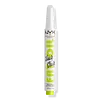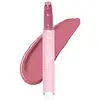What's inside
What's inside
 Key Ingredients
Key Ingredients

 Benefits
Benefits

 Concerns
Concerns

 Ingredients Side-by-side
Ingredients Side-by-side

Bis-Diglyceryl Polyacyladipate-2
EmollientPolyisobutene
Tridecyl Trimellitate
EmollientDiisostearyl Malate
EmollientPentaerythrityl Tetraisostearate
EmollientSynthetic Wax
AbrasivePolyglyceryl-2 Triisostearate
EmulsifyingPersea Gratissima Oil
Skin ConditioningRubus Chamaemorus Seed Oil
Skin ConditioningRubus Idaeus Seed Oil
EmollientTin Oxide
AbrasiveAroma
Synthetic Fluorphlogopite
Tocopheryl Acetate
AntioxidantPhenoxyethanol
PreservativeCI 15850
Cosmetic ColorantCI 77491
Cosmetic ColorantCI 77492
Cosmetic ColorantCI 77499
Cosmetic ColorantCI 77891
Cosmetic ColorantCI 19140
Cosmetic ColorantBenzyl Alcohol
PerfumingBis-Diglyceryl Polyacyladipate-2, Polyisobutene, Tridecyl Trimellitate, Diisostearyl Malate, Pentaerythrityl Tetraisostearate, Synthetic Wax, Polyglyceryl-2 Triisostearate, Persea Gratissima Oil, Rubus Chamaemorus Seed Oil, Rubus Idaeus Seed Oil, Tin Oxide, Aroma, Synthetic Fluorphlogopite, Tocopheryl Acetate, Phenoxyethanol, CI 15850, CI 77491, CI 77492, CI 77499, CI 77891, CI 19140, Benzyl Alcohol
Diisostearyl Malate
EmollientPhytosteryl/Isostearyl/Cetyl/Stearyl/Behenyl Dimer Dilinoleate
Skin ConditioningBis-Diglyceryl Polyacyladipate-2
EmollientPolyglyceryl-2 Triisostearate
EmulsifyingHydrogenated Polyisobutene
EmollientCeresin
Emulsion StabilisingMicrocrystalline Wax
Emulsion Stabilising1,2-Hexanediol
Skin ConditioningParfum
MaskingBenzyl Benzoate
AntimicrobialTocopheryl Acetate
AntioxidantPassiflora Edulis Seed Oil
EmollientBenzyl Alcohol
PerfumingVitis Vinifera Seed Oil
EmollientEuterpe Oleracea Fruit Extract
Punica Granatum Fruit Extract
AntioxidantLycium Barbarum Fruit Extract
AstringentMalpighia Punicifolia Fruit Extract
AntioxidantPassiflora Incarnata Flower Extract
Skin ConditioningCitrus Limon Fruit Extract
MaskingCitrullus Lanatus Fruit Extract
Skin ConditioningFragaria Vesca Fruit Extract
AstringentVaccinium Angustifolium Fruit Extract
Skin ProtectingPrunus Persica Fruit Extract
AbrasiveVaccinium Macrocarpon Fruit Juice
Skin ConditioningTocopherol
AntioxidantCI 45410
Cosmetic ColorantCI 15985
Cosmetic ColorantCI 77891
Cosmetic ColorantCI 15850
Cosmetic ColorantIron Oxides
CI 42090
Cosmetic ColorantDiisostearyl Malate, Phytosteryl/Isostearyl/Cetyl/Stearyl/Behenyl Dimer Dilinoleate, Bis-Diglyceryl Polyacyladipate-2, Polyglyceryl-2 Triisostearate, Hydrogenated Polyisobutene, Ceresin, Microcrystalline Wax, 1,2-Hexanediol, Parfum, Benzyl Benzoate, Tocopheryl Acetate, Passiflora Edulis Seed Oil, Benzyl Alcohol, Vitis Vinifera Seed Oil, Euterpe Oleracea Fruit Extract, Punica Granatum Fruit Extract, Lycium Barbarum Fruit Extract, Malpighia Punicifolia Fruit Extract, Passiflora Incarnata Flower Extract, Citrus Limon Fruit Extract, Citrullus Lanatus Fruit Extract, Fragaria Vesca Fruit Extract, Vaccinium Angustifolium Fruit Extract, Prunus Persica Fruit Extract, Vaccinium Macrocarpon Fruit Juice, Tocopherol, CI 45410, CI 15985, CI 77891, CI 15850, Iron Oxides, CI 42090
Ingredients Explained
These ingredients are found in both products.
Ingredients higher up in an ingredient list are typically present in a larger amount.
Benzyl Alcohol is most commonly used as a preservative. It also has a subtle, sweet smell. Small amounts of Benzyl Alcohol is not irritating and safe to use in skincare products. Most Benzyl Alcohol is derived from fruits such as apricots.
Benzyl Alcohol has both antibacterial and antioxidant properties. These properties help lengthen the shelf life of products. Benzyl Alcohol is a solvent and helps dissolve other ingredients. It can also improve the texture and spreadability.
Alcohol comes in many different forms. Different types of alcohol will have different effects on skin. This ingredient is an astringent alcohol.
Using high concentrations of these alcohols are drying on the skin. They may strip away your skin's natural oils and even damage your skin barrier. Astringent alcohols may also irritate skin.
Other types of astringent alcohols include:
According to the National Rosacea Society based in the US, you should be mindful of products with these alcohols in the top half of ingredients.
Any type of sanitizing product will have high amounts of alcohol to help kill bacteria and viruses.
Learn more about Benzyl AlcoholThis ingredient is lipid-based synthetic skin-conditioning agent derived from adipic acid and a mixture of fatty acids. It is often called a lanolin substitute.
As an emollient, it helps soften and hydrate the skin. Emollients create a barrier on the skin to trap moisture in.
Due to its fatty acid base, it may not be Malassezia folliculitis safe.
Learn more about Bis-Diglyceryl Polyacyladipate-2Ci 15850 is the pigment color red. It is an azo dye and created synthetically.
Azo dyes need to be thoroughly purified before use. This allows them to be more stable and longer-lasting.
This ingredient is common in foundations, lipsticks, and blushes. This color is described as brown/orangey red.
It has many secondary names such as Red 6 and Red 7. According to a manufacturer, Red 6 usually contains aluminum.
Learn more about CI 15850Ci 77891 is a white pigment from Titanium dioxide. It is naturally found in minerals such as rutile and ilmenite.
It's main function is to add a white color to cosmetics. It can also be mixed with other colors to create different shades.
Ci 77891 is commonly found in sunscreens due to its ability to block UV rays.
Learn more about CI 77891Diisostearyl Malate is an emollient and most often used in lip products. It comes from isostearyl alcohol, a fatty acid, and malic acid, an AHA.
As an emollient, Diisostearyl Malate helps create a thin film on your skin to trap moisture in. This helps keep your skin soft and smooth.
This ingredient is a form of glycerin with emulsifying and emollient properties.
As an emulsifier, this ingredient helps keep products together while adding a thick texture. The manufacturer states this ingredient has emollient properties. Emollients help keep the skin hydrated by trapping moisture in.
Polyglyceryl-2 Triisostearate is created by reacting diglycerin and isostearic acid. Due to the isostearic acid base, it may not be safe for Malassezia or fungal acne.
Learn more about Polyglyceryl-2 TriisostearateTocopheryl Acetate is AKA Vitamin E. It is an antioxidant and protects your skin from free radicals. Free radicals damage the skin by breaking down collagen.
One study found using Tocopheryl Acetate with Vitamin C decreased the number of sunburned cells.
Tocopheryl Acetate is commonly found in both skincare and dietary supplements.
Learn more about Tocopheryl Acetate